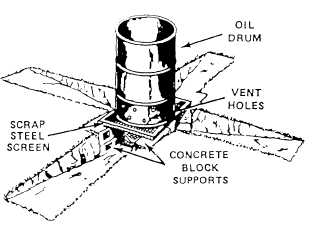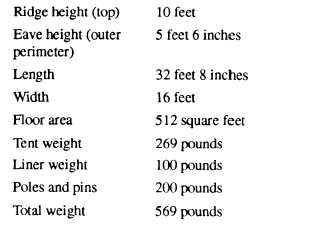| |
To make a double-walled type of food box, use one
large packing box and one that is slightly smaller. Drill
holes in the bottom of the larger box and cover its outer
walls with waterproof paper or some similar material.
Convert the top into a door with hinges. Then dig the
pit slightly larger than the box and fill the bottom with
about 4 inches of stone or gravel. Sink the box inside
the larger one, allowing for a space of from 3 to 4 inches
between the sides of the two boxes all the way around.
Stuff sawdust, straw, or grass between the two boxes to
serve as insulation. For best results, always keep this
material damp. Camouflage the box, when necessary,
by placing a wet blanket over it and covering the blanket
with leaves.
The natural refrigeration provided by both the root
cellar and the food box is supplemented by the thawing
of the frozen meats within the storage space. Frozen
meats will help refrigerate other perishables during the
period required for them to thaw. If ice is available, you
can partition off one end of the food box to form an ice
compartment.
Garbage Disposal
Garbage is best disposed of by burying or burning.
To bury garbage, dig a trench 4 feet deep or more. Dump
the garbage into the pit, packing it down in layers. Then
cover the exposed layer with a few inches of dirt each
day. When you abandon the garbage site, cover it with
a minimum of 2 feet of mounded earth.
To incinerate garbage, you must first remove all
excess moisture. The cross-trench incinerator (fig. 11-5)
provides one of the best methods of burning garbage. To
construct such a trench, dig two trenches 8 feet long, 1 foot
wide, and 1 foot deep, that cross at their centers. The
bottom of each trench should taper up to the level of the
ground toward the ends. A grate made of a piece of scrap
iron or pipe about 24 inches long is built over the centers.
At the intersection of the trenches, build a coal or wood
fire. When the fire has become hot enough, add rubbish
or drained garbage as fuel. This incinerator functions
best if three of the four sides of the trenches are blocked
off, with the open side facing into the wind.
This type of cross-trench fire can be used for
cooking as well as incinerating. Two cross-trenches
provide enough cooking facilities to prepare meals for
100 people and six of them provide enough cooking
facilities to prepare meals for 500 people.
To dispose of cans, you can wash them and use them
as substitutes for cooking and eating utensils. You also
can open both ends, flatten them, and bury them with
the garbage. Glass jars also can be used as substitute
eating utensils. When disposing of glass jars, break
them up and bury them with the garbage.
Liquid wastes, such as grease, may be burned or
buried with the garbage. The exception is any usable
grease that can be used for cooking. Other wastes are
best disposed of in the soakage pit (fig. 11-6). This pit
should be at a minimum of 25 feet from the kitchen area.
FIELD KITCHEN TENTS
This section of the chapter presents you with the
knowledge required to unpack and setup a field kitchen
tent. You also will become familiar with the procedures
used for packing and storing tents once field mess
operations are complete.
The general-purpose medium (GPM) tent (fig.
11-7) is designed for field kitchen use. This tent is
rectangular and pole supported. It consists of cave
poles, door pies, center upright poles, a ridge pole, and
a liner. The general specifications are as follows:
Figure 11-5.-Cross-trench incinerate.
11-4
|


